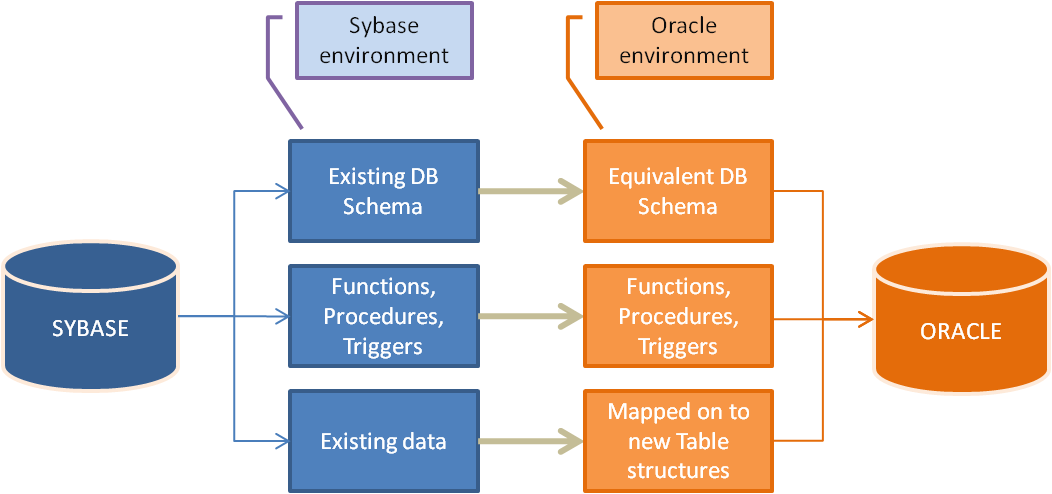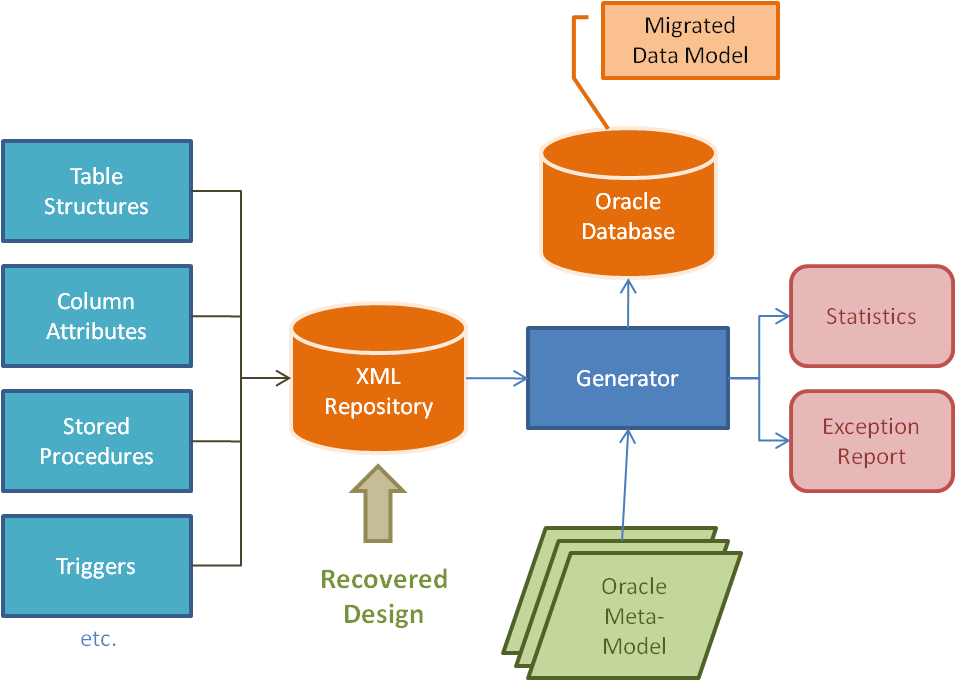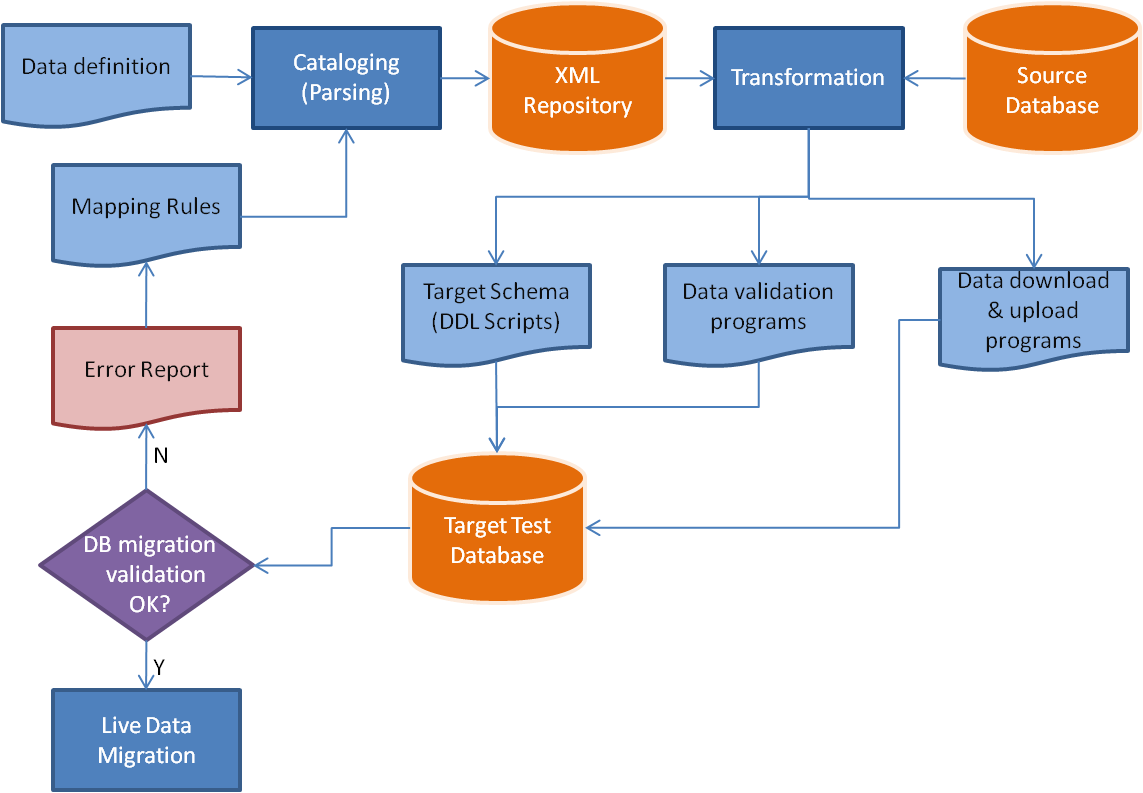| DATA STORAGE MIGRATION |
You may wish to migrate your data storage to a new database, and/or consolidate your databases into a single unified database. |
We help you modernize just the database layer (database access) and leave the application as it is. As an example: a customer can migrate IDMS, IMS, VSAM, ADABAS, SYBASE, etc. databases to a database (DB2, Oracle, etc.) and if the application is in COBOL code then it will still be in COBOL code when the database migration is completed. This will require: |
- Separating the Data Access Layer and the Database Layer from the rest of the software.
- Transforming these as required.
- Migrating the data to the new database.
|
The rest of the software will remain the same but will now work off the new database.
|
| Representative Example: Sybase to Oracle Migration |
Here is an example of migrating from SYBASE to ORACLE. |
Our overall migration methodology will be based on model driven approach to software modernization as explained in Modernization via platform migration. The approach offers a balanced combination of automated tool-based approach and manual intervention to give you the best of both worlds: |
- The speed, accuracy and lower cost of automation; and
- The intelligent decision-making power of human intervention.
|
| The database migration can be conceptualized as follows: |
- The existing Sybase database schema will be replicated on Oracle.
- All attendant Sybase software artifacts - such as Stored Procedures, Triggers and Functions - will be converted to Oracle.
- The existing data be moved from Sybase to Oracle.
|
| In parallel we would also be transforming the Data Access Layer of the host application so that the new database can be accessed seamlessly by the host application. |
The more detailed steps are described below. |
Data Model Recovery (Reverse Engineering) |
We shall reverse engineer the schema definitions of the input database and recover the data model. |
This will be done by our parsers with reference to a Sybase Meta-Model as shown below. |
 |
The parsers will interpret the Sybase Database components with reference to the Sybase Meta-Model and extract all possible software artifacts into an XML Repository. |
Schema Migration (Forward Engineering) |
The forward engineering tool is conceptually the reverse of the parsers. It is a generator. |
It will input the XML Repository and generate the new schema for Oracle with reference to the Oracle Meta-Model. In effect, this transforms the Sybase Data Model into an Oracle Data Model. |
All required data type mappings will be undertaken in this phase as well. |
The schema conversion from Sybase to Oracle will be done based on one to one mapping of the existing fields. |
Below is the forward engineering schematic |
 |
Generation of Data Migration programs |
The data migration tool takes as input the source and the target schema and based on the transformation rules defined by using the tool's interface, creates data migration programs which can be used to extract data from the source database, transform data based on rules provided and load to the target schema. |
The tool can also work in an online mode by directly connecting to the source and target database. |
The tool provides for posting of custom log messages from within the rules. This facility provides valuable insight as to what has gone on during a particular run of the data migration process. |
Data Validation |
Data validation programs are also generated by our forward-engineering schema migration tool-set. These programs will validate the generated mapping rules by sampling the actual data from the source databases and generating error reports. |
Appropriate inclusion / modifications are then applied on the generated set of rules to bring the error report contents to an acceptable limit and determine the final set of effective rules. |
Data Migration Process Schematic |
This whole process is depicted in the diagram below. |
 |
Migration of Sybase Procedures and Triggers |
A forward engineering tool will migrate the Transact SQL procedures, functions, and triggers to Oracle PL/SQL. |
It also takes care of Sybase T-SQL special features like Temporary table, "@@" Global variables, T-SQL result-set processing, T-SQL cursor handling statements, Transaction handling statements, T-SQL built-in functions, and so on. |
Migration of Sybase Views |
The forward engineering tool will also migrate all Sybase Views to the Oracle platform. |
Transformation of the Host Application Source Code |
This is a little more complicated and may or may not involve a lot of work depending on the nature and quality of the host source code. |
The following schematic depicts the transformation required to migrate a COBOL-Sybase application to a COBOL-Oracle environment |
 |
In this instance we assume that the host COBOL application is using Native Sybase API to access the Sybase database. We will extract the Data Access Layer from the original source code, and transform it into Pro*COBOL by applying our MDA methodology as shown in the schematic above. |
Mission Accomplished |
 |
| |